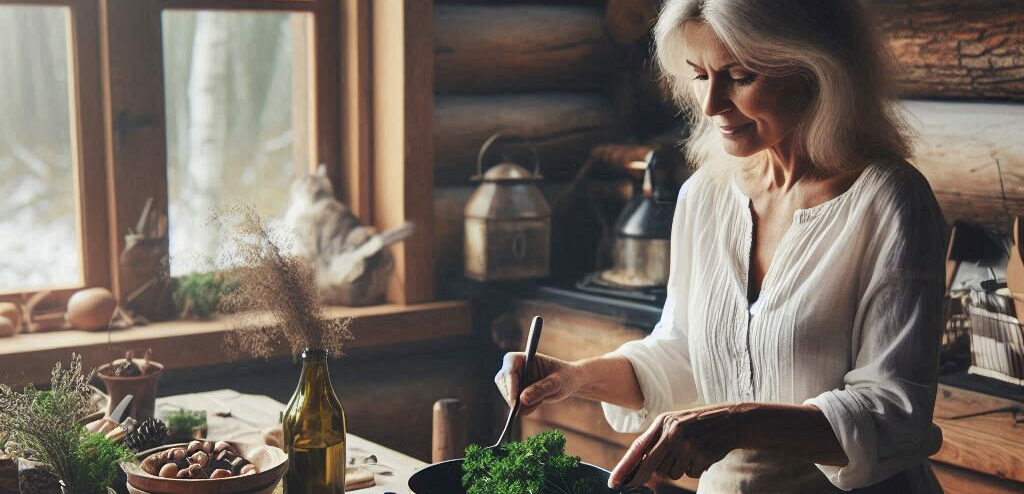Imagine the serenity of cooking in a cozy cabin nestled amid nature’s splendor. You’re about to explore the nuances of creating flavorful meals with a touch of simplicity. This isn’t just about making do with less; it’s about discovering the ingenuity and satisfaction that comes with cabin cooking.
Let’s face it, cooking in a cabin brings a set of challenges not found in your typical home kitchen. You’re working with what’s on hand, often with limited ingredients and cookware. But these constraints can fuel creativity, leading to a truly rewarding culinary adventure.
Just imagine…Your very own Cabin Cook Book! Click on this image below and read all about it:
I’m going to show you how to navigate these challenges and make the most of your cabin kitchen. You’ll learn about everything from meal planning with a limited pantry to maximizing limited counter space. And don’t worry too much about having a full set of gourmet tools – I’ll guide you on how to create delicious meals with just the basics.
After embracing the cabin kitchen mindset, you’re going to need to stock your shelves. That’s where we’ll head next. We’ll cover the essentials every cabin pantry should have, ensuring you’re prepared to cook hearty meals that resonate with the feel of cabin living. Let’s step into your cabin pantry and see how to stock it like a pro.
Stocking Your Cabin Pantry: Essentials for Rustic Cooking
When you’re cooking in the confines of a cabin kitchen, every inch of space is premium real estate. That’s why choosing the right pantry staples is key to your culinary success. Think of it as curating a collection of ingredients that are versatile enough to pull together a meal on the fly while being mindful of limited storage.
Start with the basics: a good selection of spices, grains, canned goods, and oils. These ingredients can be the backbone of countless meals, from a hearty morning oatmeal to a comforting evening stew. And if you’re going to have a few perishables around, pick those that have a longer shelf life, like root vegetables and hard cheeses.
Here’s the deal: You want to mix convenience with nutrition. Foods like rice, pasta, and lentils are your best friends because they are nutrient-dense, have a long shelf life, and are incredibly adaptable. Plus, they’re pretty forgiving if you’re still finding your feet with cabin cooking.
Don’t forget, wherever your cabin is nestled, there’s bound to be local produce and goods. Visiting nearby farmers’ markets or local stores can give you a sense of community while stocking up on fresh and flavorful ingredients that’ll take your meals to the next level. Berries, greens, fresh-caught fish—these can all inspire a dish that’s both fresh and satisfying.
These staples don’t just prepare you for success; they pave the way for creativity, which leads to the fun part—whipping up delicious meals in your cozy retreat. With the right ingredients on hand, you’re all set to dive into the art of cabin cuisine.
Creative Cabin Cuisine: Recipes and Techniques
So you’ve got a stocked pantry and you’re ready to turn those ingredients into mouth-watering meals. I’m going to walk you through some simple yet indulgent recipes tailored for a smaller cabin kitchen, where you might not have all the luxury gadgets you’re used to. But guess what? They are not necessary to whip up something superb.
Let’s start with a one-pot wonder. Thick and hearty stews or soups are perfect for cabin life. They’re comforting, and all you need is a single burner. Choose something that resonates with you, maybe a classic beef stew or a vegetarian chili. You can always swap in ingredients to suit your taste or what’s in season locally.
Now, if you have a cast-iron skillet, I’m about to blow your mind. From savory dishes to sweet treats, this is a must-have in your cabin kitchen. Think skillet cornbread as a side or a berry cobbler for dessert. There’s a lot of opportunity in that one pan.
Some folks worry about not having an oven, but you can replicate baking by ‘dutch oven baking’ on a stove top or fire. I’d recommend starting with something forgiving, like a batch of gooey brownies or a simple bread. It’s all about controlling the heat and time.
And hey, don’t stress too much about perfection on your first go. Adjust your approach down the line based on experience. You’re not just feeding bodies here; you’re creating memories and nothing beats a meal cooked with a dash of adventure.
Now, as we move towards embracing cabin life fully in the kitchen, it’s vital to consider the practical aspects beyond the cooking. In the next section, we’ll shift gears a bit to cover some cabin kitchen fundamentals. I’m going to help you with fire safety tips, navigating food storage protocols, and how to leave a small environmental footprint while still enjoying those hearty, home-cooked cabin meals.
Living the Cabin Life: Safety, Sustainability, and Satisfaction
Cooking in your cabin kitchen is more than just a way to fill your belly; it’s a vital part of the cabin living experience. With the right approach, it can be safe, sustainable, and incredibly satisfying.
Fire safety is paramount. Always keep a fire extinguisher on hand and ensure your stove and any other appliances are in good working order. Remember to never leave cooking unattended — it’s easy to get distracted by the great outdoors.
Storage is key to preventing food spoilage and keeping unwanted critters at bay. Use airtight containers and cool storage spots to prolong the freshness of your ingredients. And as for those leftovers? Embrace them! They can save time and reduce waste.
Sustainability is about making choices that protect your surroundings. Opt for eco-friendly products, and if you’re in a region that allows, consider composting organic waste. Forage for ingredients if you’re familiar with local flora — but always exercise caution and respect local regulations.
And let’s not forget the satisfaction part. There’s something deeply rewarding about enjoying a meal you’ve prepared in a cozy cabin setting. It could be a hearty stew simmering on the stove or the smell of pancakes on a lazy Sunday morning that makes your cabin feel like a home.
Incorporate local traditions and flavors into your cooking. It connects you with the region and can make each meal an adventure. Sharing food with fellow cabin dwellers or neighbors can also foster a sense of community.
So there you have it. Embrace these practices, and you’re going to find that safety, sustainability, and satisfaction are your faithful companions in the cabin cooking journey. And remember: the simple moments — a warm meal, good company, the serenity of nature — are often the ones that lodge themselves deepest in our memories.
As an Amazon Associate I earn from qualifying purchases.






